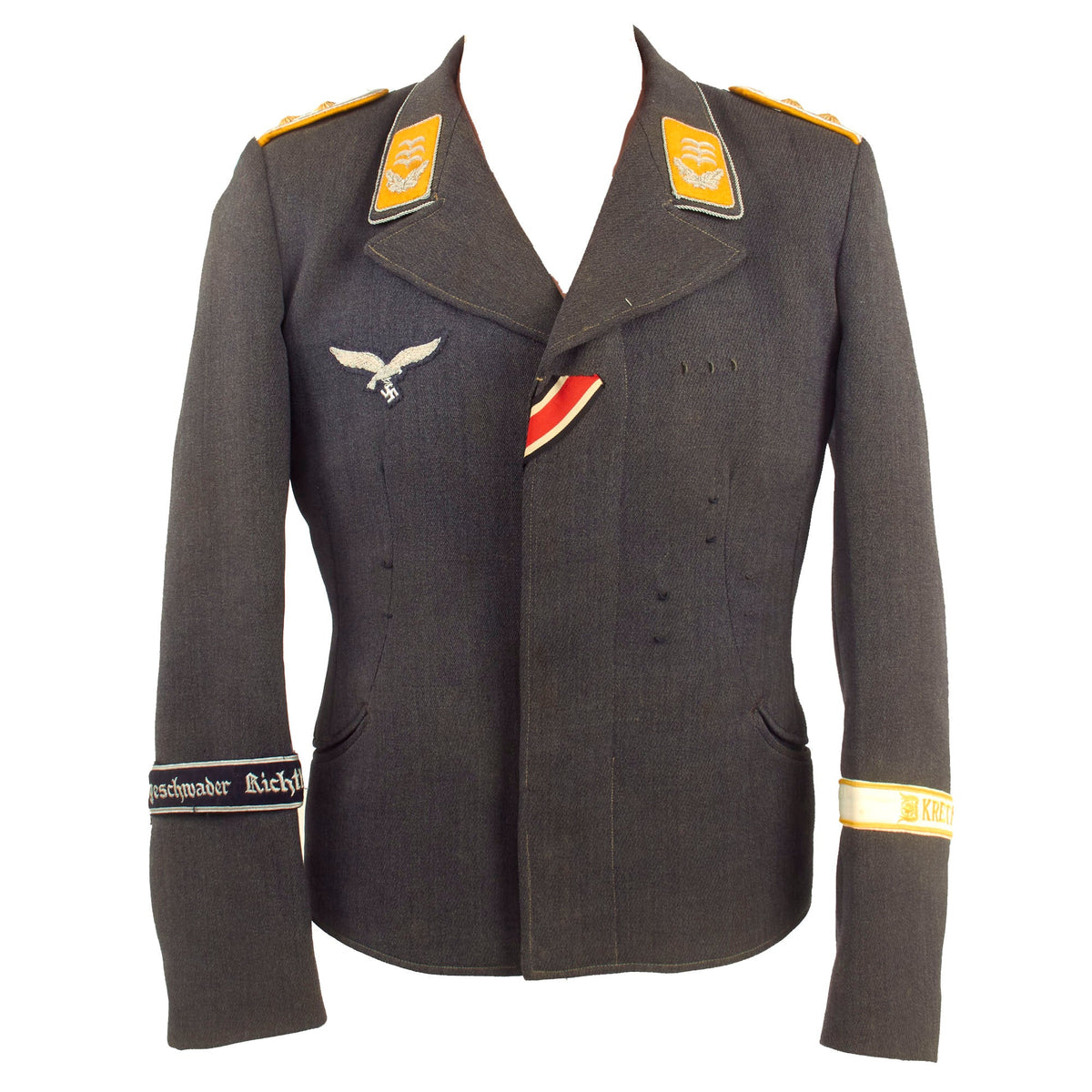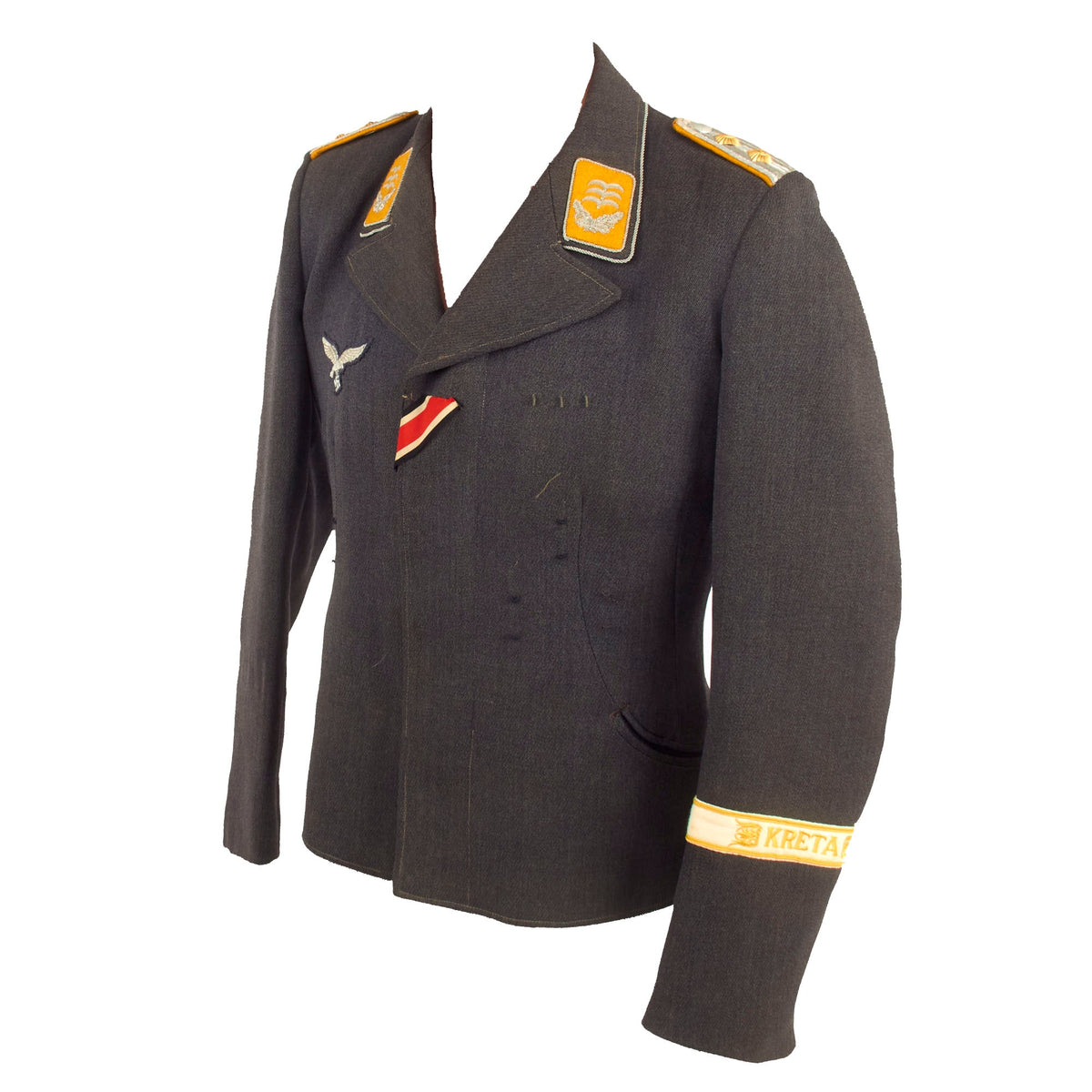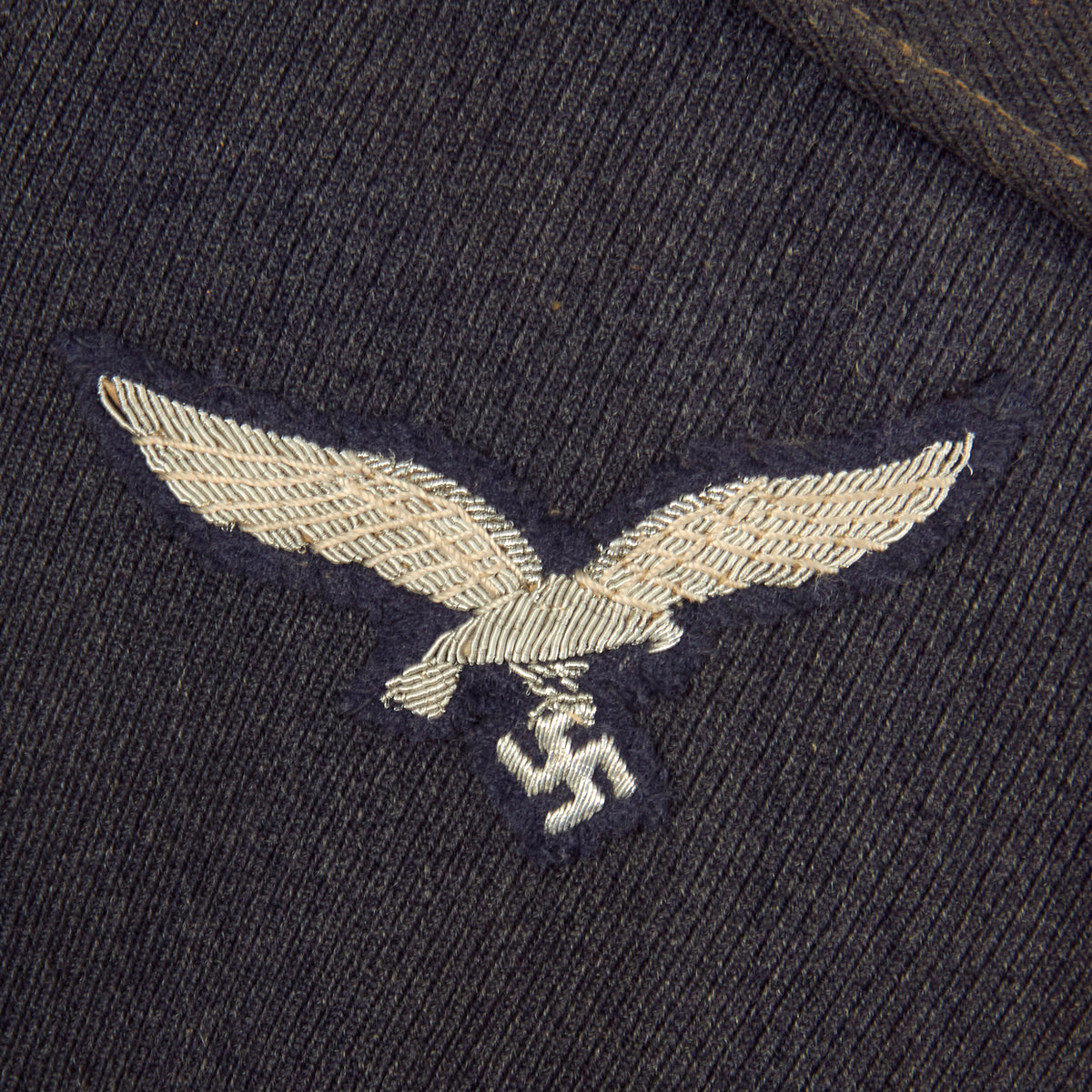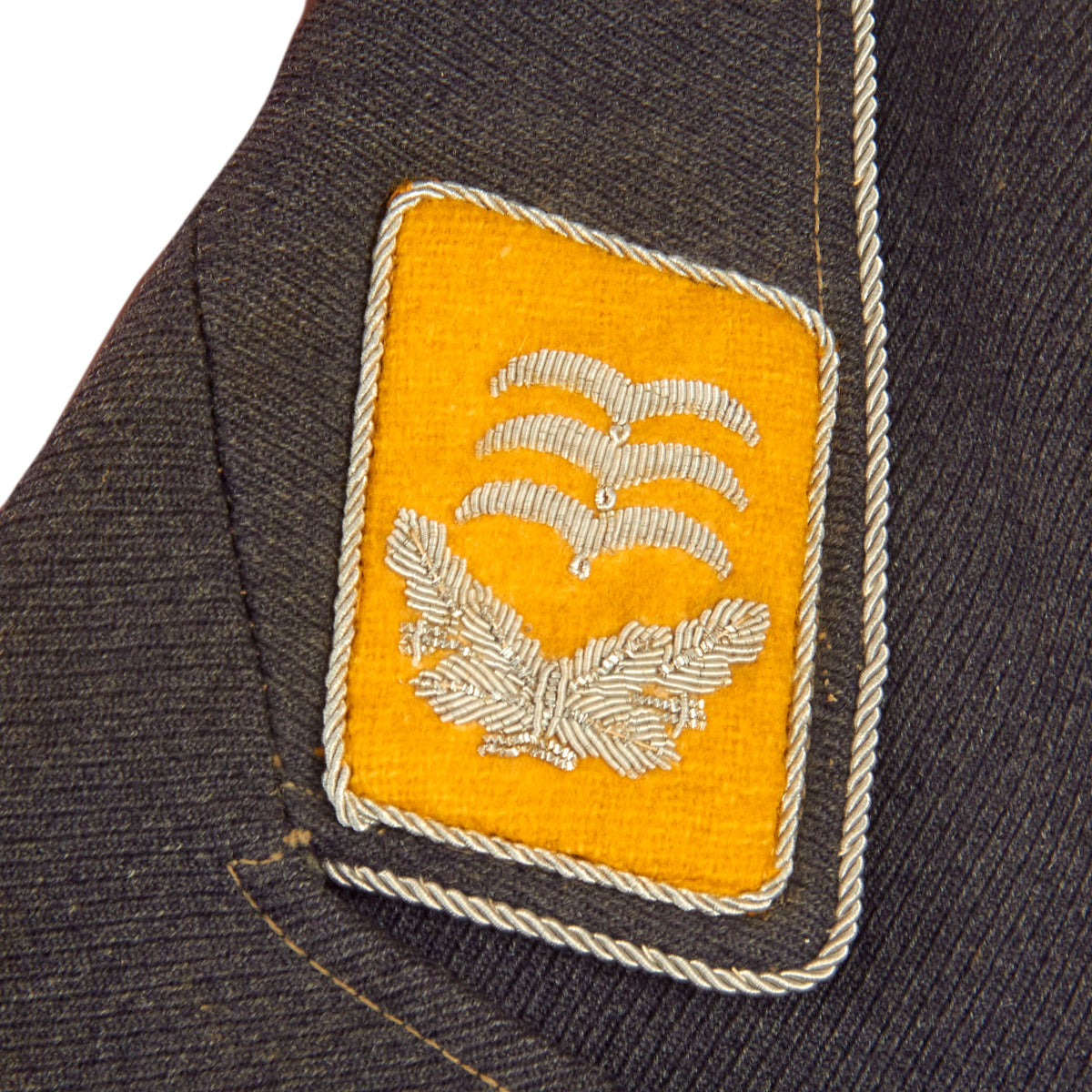Original German WWII Luftwaffe Flight Branch Hauptmann’s Fliegerbluse Tunic with Jagdgeschwader Richthofen & KRETA Cuff Titles Original Items
$ 2.995,00 $ 748,75
Original Item: Only One Available. This is a fantastic WWII German Luftwaffe Flight Branch Officer’s Two Pocket Fliegerbluse (Flight Blouse) Service Tunic, with some great wear from service. It’s really got that “broken in” look, meaning it was really out there, and not sitting in a depot. It is equipped with a very desirable “hidden” four bakelite button front closure and small “slash” pockets. These looked great in service, with a very streamlined look, and it is a relatively short design, somewhat like an “Ike” jacket. It was produced in the standard Fliegerblau (Flyer’s Blue) whipcord weave wool, and really looks great. It is fitted with some lovely insignia, including a very rare KRETA Ärmelstreiffen (Crete cuff title).
It also definitely had another cuff title installed on the right sleeve, and when we received this tunic it had a fantastic silver bullion embroidered German WWII Luftwaffe Officer’s Jagdgeschwader Richthofen Ärmelstreiffen (cuff title) in the right pocket. This was one of a series of commemorative honor cuff titles that were introduced by the Luftwaffe to honor fallen comrades and heroic pilots of WWI, and there was no more famous squadron in WWI than the “Jagdgeschwader Richthofen.” This was the squadron of the legendary Manfred von Richthofen, better known as Der Rote Baron – “The Red Baron”. He is considered the “Ace of Aces” of the first world war, credited with 80 air combat victories before he was shot down. We have not been able to find much information on what qualified members of the Luftwaffe to wear these, however we have inspected it inside and out, and it is completely correct.
The interior is lined with Luftwaffe blue gray fabric, which feels like a cotton rayon blend, and the sleeves are lined with striped cotton, which is typical. There is an inside pocket on the left side, and we were not able to see any maker or issue markings on the interior. There is degradation of the liner around the inside of the neck area, which is usually the first area to get damaged, and there has been tearing of the lining fabric.
The right breast of the uniform has a correct bullion embroidered officers eagle sewn in place with the correct stitching pattern. It is only stitched to the outer layer of fabric, so it is the original eagle installed on this uniform tunic. The collar of this officer’s tunic has a twisted bullion border, correct for a Luftwaffe officer’s fliegerbluse. The attached Kragenpatten (Collar Flaps) are in Goldgelb (Gold-Yellow), the correct Waffenfarbe (Corps Color) for Aviator troops such as pilots, air crew, and ground personnel, as well as Fallschirmjäger (parachute troops). The Schulterklappen (Shoulder Boards or Epaulettes) have the same color piping, and have four rows of silver “Russia Braid” around the edge with two rank “Pips” added, indicating the rank of Hauptmann (Captain). This is confirmed by the collar insignia, which each show three “gull wing” insignia over a wreath.
The top buttonhole on the tunic has a Red / White / Black ribbon installed, indicating that the officer had received the Iron Cross 2nd Class Award. There are also thread loops for a ribbon bar, as well as for several awards on the left side, and there is even one on the right side. We assume that this uniform was owned by a pilot who was highly accomplished, and wanted people to know it.
Condition is very good, especially considering the amount of service that this tunic saw. Most of this is on the interior, so it still displays wonderfully.
A great chance to pick up a lovely Luftwaffe Flight Officer’s Two Pocket tunic with some fantastic cuff titles. This would display great as is, or could be dressed up with some medals on the left side.
Approx. Measurements:
Collar to shoulder: 9″
Shoulder to sleeve: 25.5”
Shoulder to shoulder: 15”
Chest width: 18.5″
Waist width: 17″
Hip width: 19″
Front length: 27″
The KRETA Ärmelstreiffen (Crete cuff title) was the first in a series of four campaign award cuff titles and was introduced on October 16th 1942 It was awarded to personnel who participated in the successful assault on the Greek, Mediterranean island of Crete from May 20th to June 1st 1941. The cuff title was considered a military combat decoration, and as such, was bestowed with a corresponding award possession document and entered into the recipient’s official military service documentation. Bestowal of the award was opened to personnel in all three branches of service who had actively been involved in the invasion of Crete. The “Kreta” cuff title was worn on the lower left sleeve of the field blouse, service tunic and greatcoat by all eligible personnel with no differentiation for rank.
The “Kreta” cuff title utilized acanthus leaves as ornamentation which is a perennial herb or shrub native to the Mediterranean area and has been used through-out ancient history as ornamentation in art and architecture. The acanthus leaves symbolize quality, strength, longevity and creativity. The “Kreta” cuff title was manufactured in two slightly different versions with one version having seven acanthus leaf petals and the other with nine. Due to the significant role that the German Fallschirmjäger (Paratroopers) played in the successful invasion they were awarded a large percentage of the “Kreta” cuff titles.
Of Note: The other three campaign award cuff titles consisted of the “Afrika” cuff title as introduced on January 15TH 1943, the “Metz” cuff title as introduced on October 24TH 1944 and the “Kurland”, (Courland), cuff title as introduced on March 12TH 1945.
The Luftwaffe, the air force of the German military during the Third Reich, was established in 1935. Over the next 10 years, Luftwaffe troops wore a huge variety of uniforms. Enlisted men generally wore uniforms issued from military depots. Most enlisted soldiers had wool trousers and a short jacket with two internal lower pockets, called a Fliegerbluse, as well as a dressier 4-pocket tunic, the Tuchrock. Officers wore the same general uniform styles, but as officers had to supply their own uniforms, they usually wore tailor made versions. There were also myriad varieties of specialized uniforms worn by certain units or in specific situations, from the tuxedo-style “gala” formal wear uniform of the pre-war period, to the plain coveralls worn by crews of anti-aircraft cannons. There were work uniforms, tropical and summer uniforms, and camouflage clothing for airborne troops and other Luftwaffe soldiers in ground combat. Flight crews had their own specialized gear, including leather jackets and warm, electrically heated suits. Most but not all Luftwaffe uniform jackets bore the Luftwaffe emblem of a flying eagle holding a swas.
Fast Shipping with Professional Packaging
Thanks to our longstanding association with UPS FedEx DHL, and other major international carriers, we are able to provide a range of shipping options. Our warehouse staff is expertly trained and will wrap your products according to our exact and precise specifications. Prior to shipping, your goods will be thoroughly examined and securely secured. We ship to thousands clients each day across multiple countries. This shows how we're dedicated to be the largest retailer on the internet. Warehouses and distribution centres can be located throughout Europe as well as the USA.
Note: Orders with more than one item will be assigned a processing date depending on the item.
Before shipping before shipping, we'll conduct a thorough inspection of the items you have ordered. Today, the majority of orders will be delivered within 48 hours. The delivery time will be between 3-7 days.
Returns
The stock is dynamic and we cannot completely manage it because multiple stakeholders are involved, including our factory and warehouse. So the actual stock may alter at any time. It's possible that you may not receive your order once the order has been made.
Our policy is valid for a period of 30 days. If you don't receive the product within 30 days, we are not able to issue a refund or an exchange.
You can only return an item if it is unused and in the same state as the day you received it. You must have the item in its original packaging.
Related products
Uncategorized
Uncategorized
Uncategorized
Uncategorized
Uncategorized
Uncategorized
Uncategorized
Uncategorized
Uncategorized
Uncategorized
Uncategorized
Uncategorized
Armored Burgonet Helmet & Polearm from Scottish Castle Leith Hall Circa 1700 Original Items
Uncategorized
Uncategorized
Angolan Rebel 1970s era 60mm Inert Display Mortar from Angolan Civil War Original Items
Uncategorized
Uncategorized
Uncategorized













































































